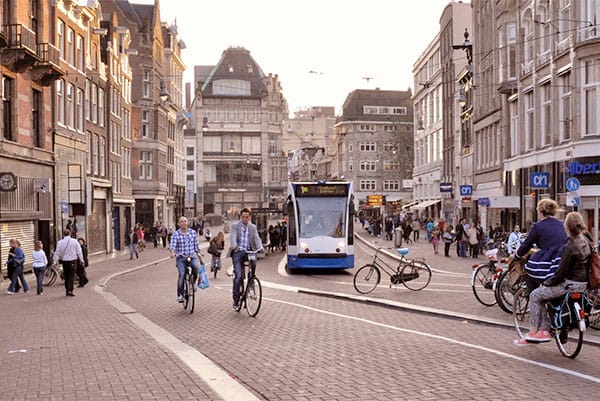
Sidewalks can be an obstacle to wheelchair travel in many European cities. Not in Amsterdam! Wheelchair users will be able to easily navigate the city with these tips. If you have the strength or the wheelchair battery life to roll, you may prefer to do that instead of utilizing the city’s public transportation.
What makes Amsterdam easy to roll?
The city’s geography is largely flat, or level. You won’t be rolling up and down steep hills. This means you won’t have to exert a great deal of energy to explore the local area, and you can roll at a leisurely pace as your friends walk alongside.
Curb cuts are built into the sidewalks throughout the city. When you reach an intersection and need to cross street, you won’t have to worry about rolling over or climbing up a curb. The ramps are laid into the cement, so you won’t typically encounter a lip or curb of more than 1-2 inches.
Sidewalks are smooth in the majority of the city’s popular tourist areas. Broken and cracked pathways do exist, but they’re not typically overwhelming.
Amsterdam is a city of bicyclists, and this offers wheelchair users a major advantage. If you encounter a sidewalk that is in bad shape, roll your wheelchair into the bike lane. Make sure to watch out for bicycles! Don’t worry – the bicyclists are on wheels too, so they will understand your need for a smooth and barrier-free ride.
What obstacles will I encounter?
The city’s on-street trams are a key component of public transportation. These trams run on tracks. When crossing a street, you will need to roll over these tracks as well. Although they are embedded into the street itself, they stick out 1-2 inches. You’ll need a bit of strength to roll your manual wheelchair over them, and it will be bumpy. I’ve never had any issues crossing the tram tracks in my power wheelchair.
Cobblestones. Although Amsterdam doesn’t have nearly as many cobblestones as cities like Brussels, Belgium, it still has some. Cobblestones will jerk you around a bit in your wheelchair, and do take some grit to cross, especially for those in manual wheelchairs. Power wheelchairs handle them fine, but definitely bounce around. The majority of sidewalks are NOT made of cobblestones. Certain areas do contain them, with the most popular being Dam Square, where sights like the Royal Palace are located. Common sense tip: Plan the shortest path possible across these bumpy pathways!
Conclusion
I rate the ease of maneuverability on the Amsterdam sidewalks as “good.” I do this understanding the benefits of the bike (wheelchair!) lanes, and recognizing city’s pedestrian-friendly grade. Amsterdam actually outperforms many U.S. cities in sidewalk accessibility!
Have you visited Amsterdam?
What did you think of its “roll-ability?”
Have I missed anything?
Post your thoughts in the comments below!

